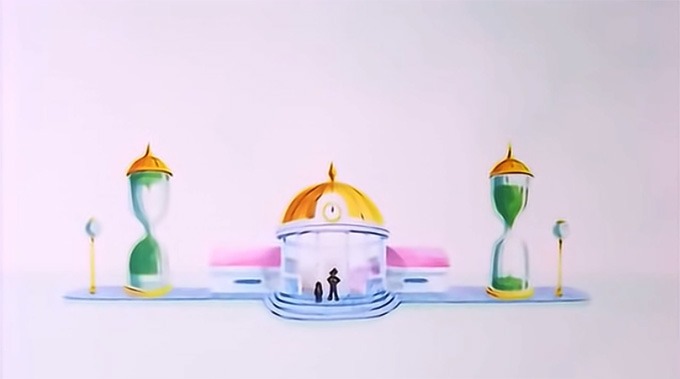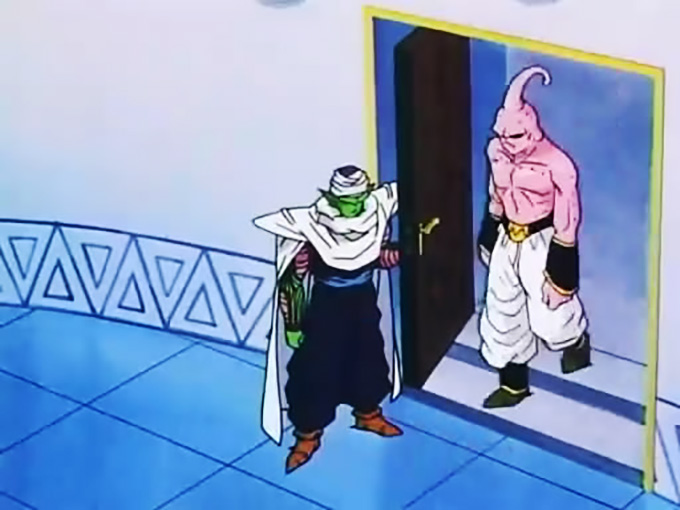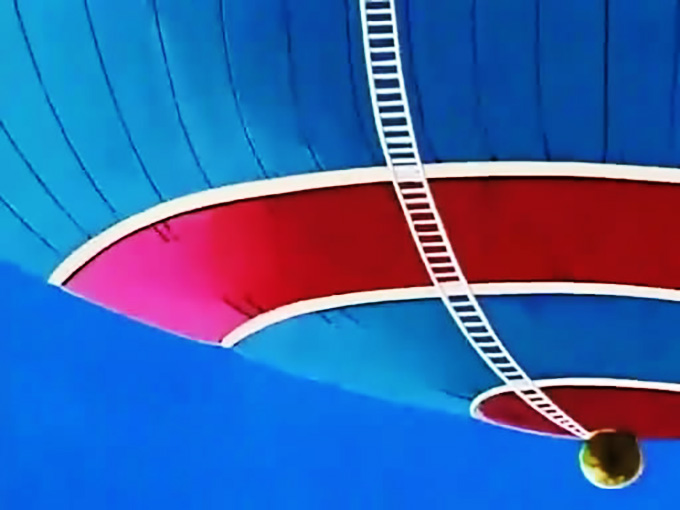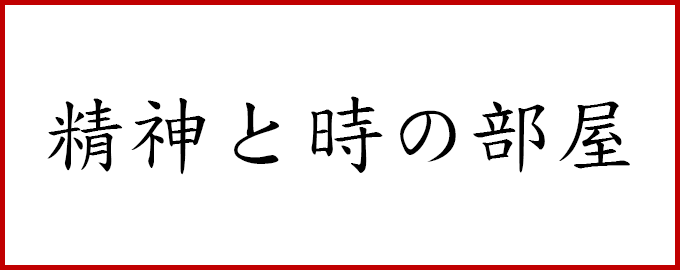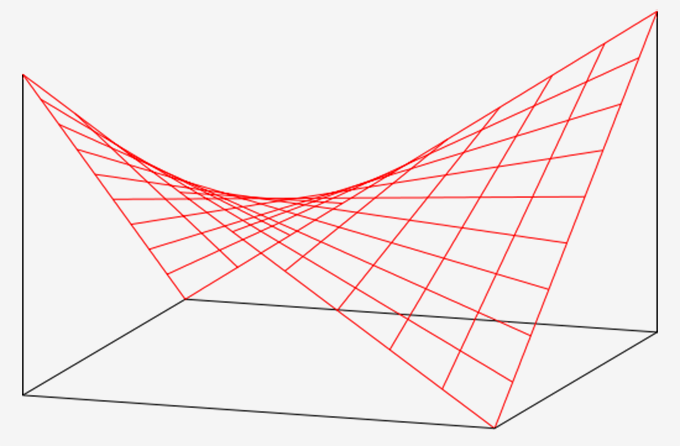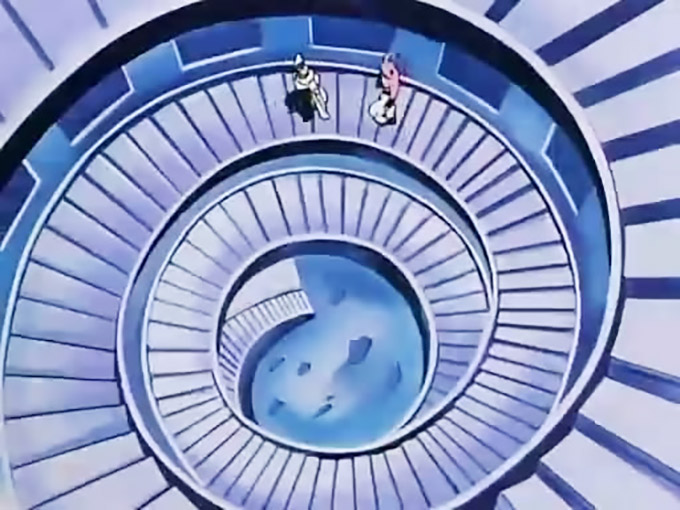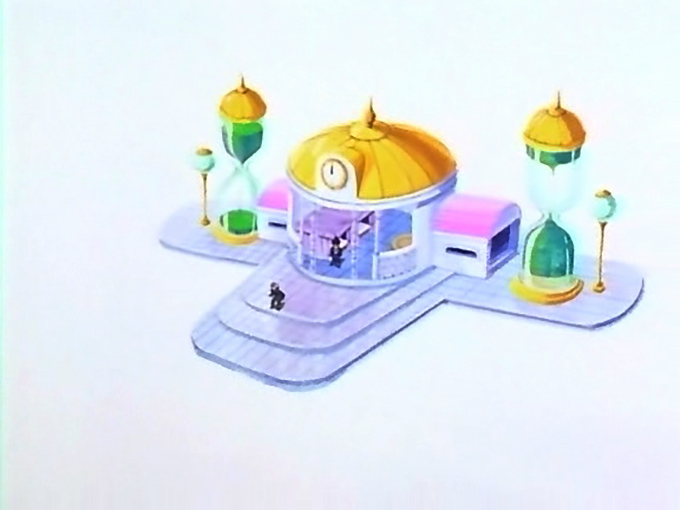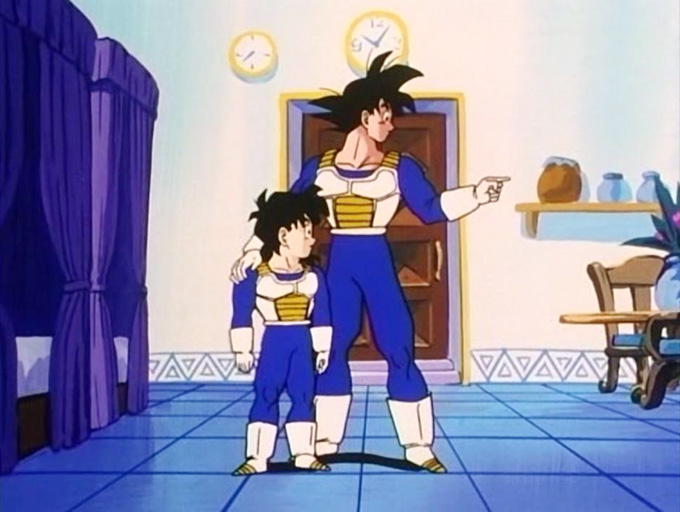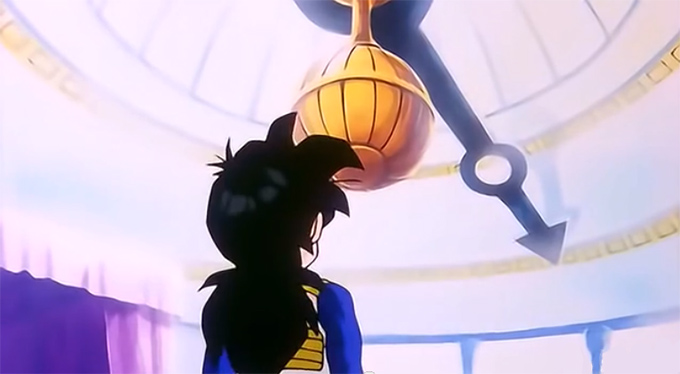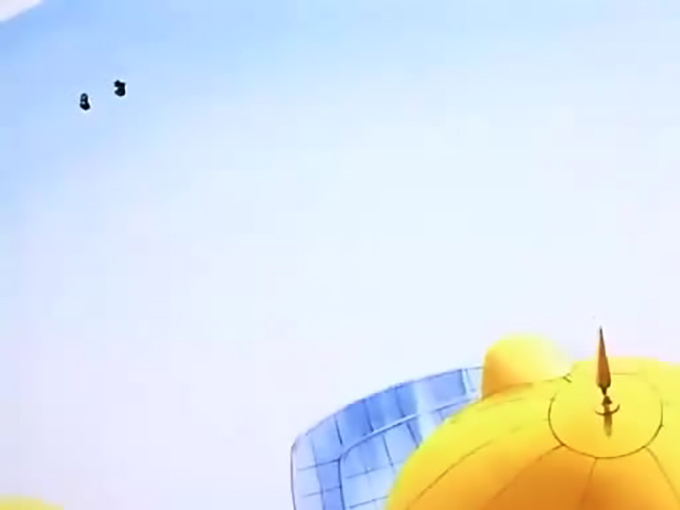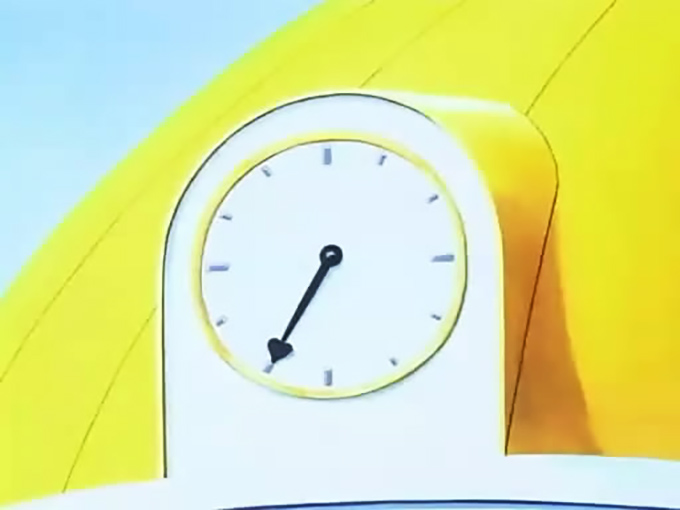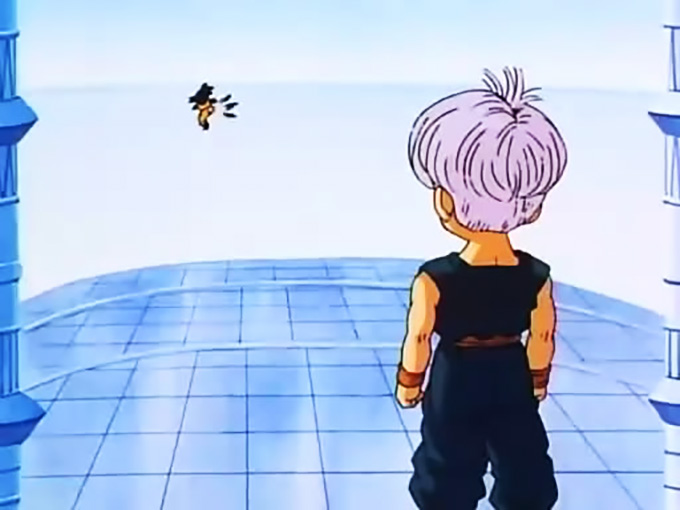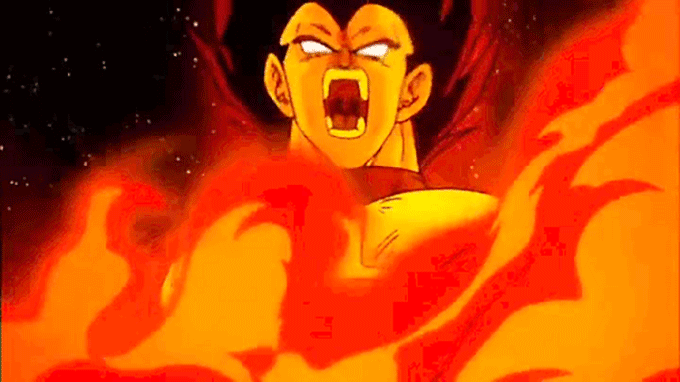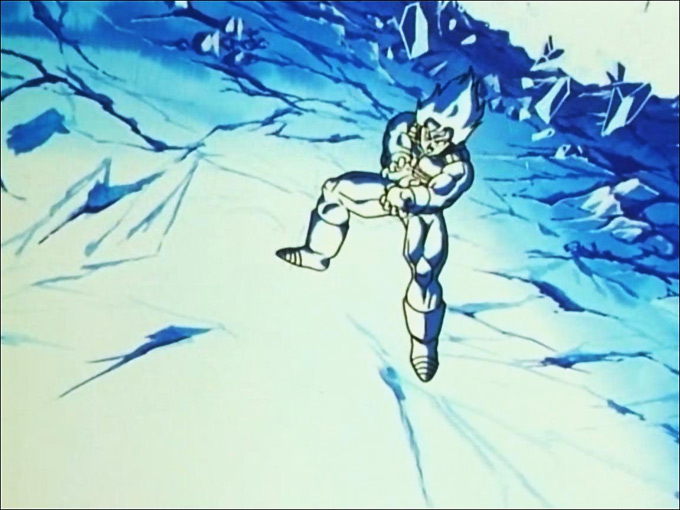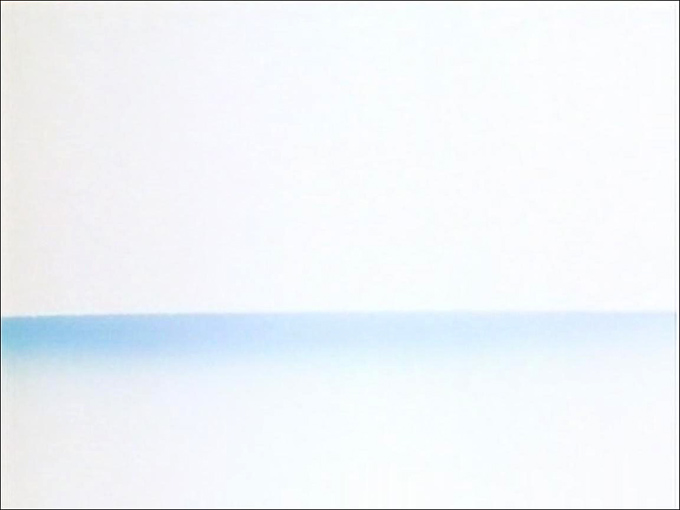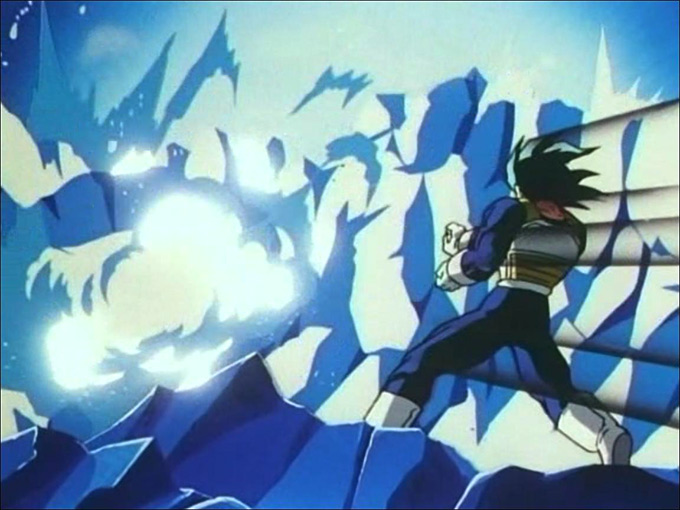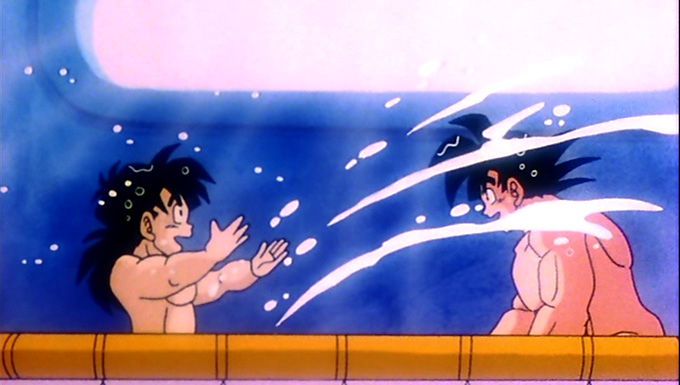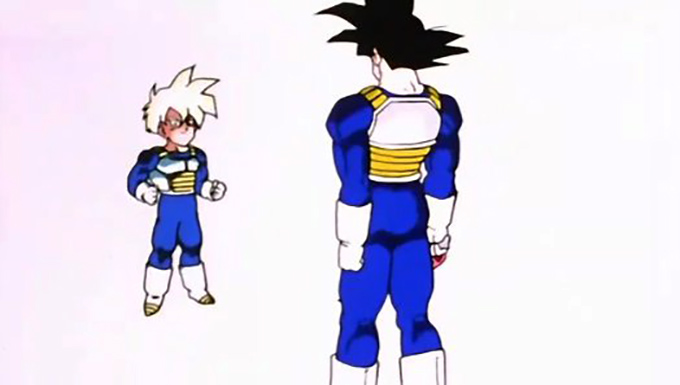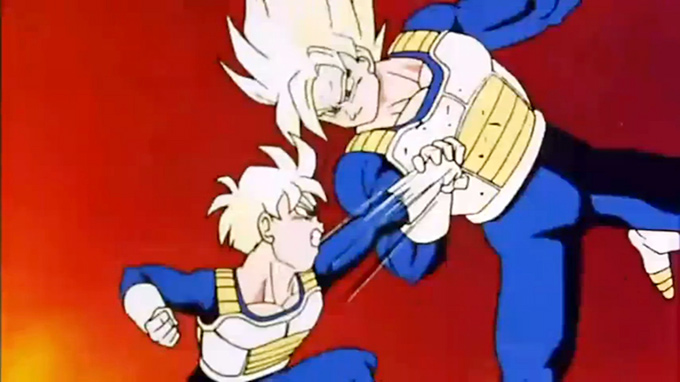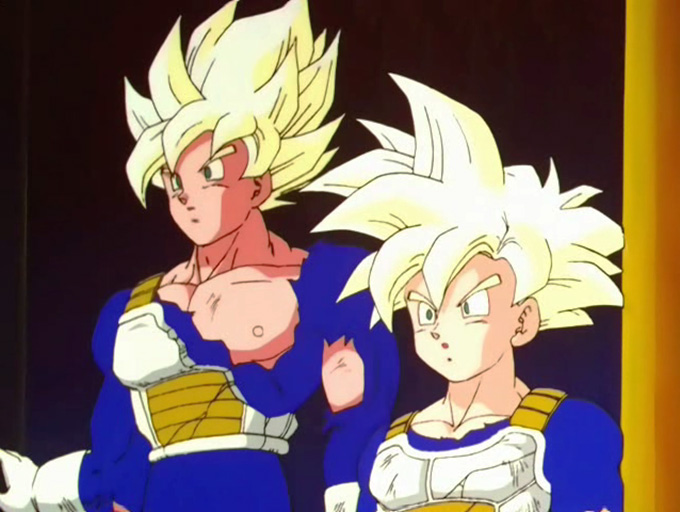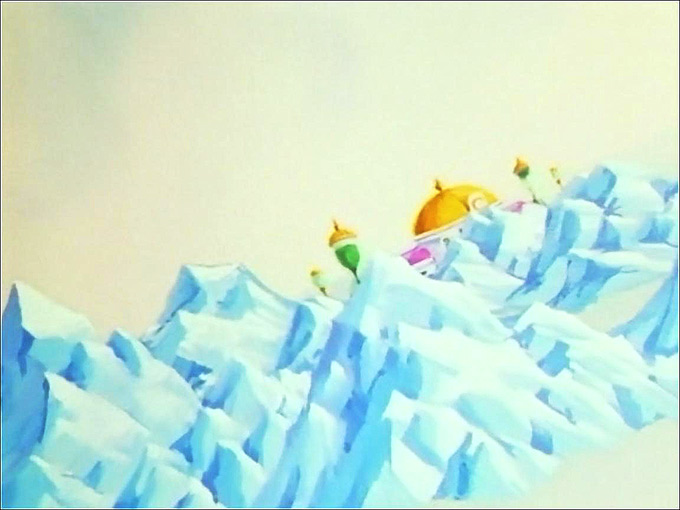The Room of Spirit and Time Explained
The Room of Spirit and Time is a special dimension where the Z-Warriors train to refine their spirit, and it has profound inner meaning.
Will you walk through the door?
What is the Room of Spirit and Time?
The Room of Spirit and Time is a magical room inside Kami’s Palace that has its own time field and offers a unique training experience.
Because it has its own time field, 1 year in the The Room of Spirit and Time equals 1 day in the real world. This is valuable to Vegeta because he struggled to find a way to make his training more efficient, and when Goku tells him about the room he gets excited.
The room has 10 times earth’s normal gravity as soon as you step off the entrance platform, and the temperature fluctuates between extreme heat and extreme cold.
It is located on the lowermost level of the Heavenly Realm (tenkai, 天界), below Kami’s Palace (Kami no kyūden, 神 の 宮殿). The Heavenly Realm is a large, half-spherical platform located above Karin’s Tower that is in synchronous orbit above the earth.
Kami’s Palace is where Kami (神) the Shinto word for a God or spirit, lives. It’s a title given to the being who assumes the throne and becomes God of the Dragon World. But FUNimation chose to call the entire structure “Kami’s Lookout” to avoid mentioning God and Heaven.
And it’s not called Kami’s Temple, either, as temple is written in Japanese as ji (寺), or when it’s Shinto specific as kamisha (神社).
Goku trained here once when he was a child. He then takes Vegeta, Trunks and Gohan to train here during the Cell Saga.
Goku says you can only enter the room 2 times. If you are in there for longer than 2 years (48 real time hours) then you will be trapped inside forever as the entrance will vanish.
It’s never explained why this rule exists, but perhaps as a story contrivance by Akira Toriyama to keep Vegeta out of the room and in the real world, who would otherwise be in there all the time.
There is only enough food to sustain 2 people for 1 year at a time, so that’s why usually 2 or less people go in at once, but it been shown that at least up to 4 can be in there.
Toriyama also likes to write his character interactions in pairs, so enforcing a 2 person limit works well.
The room is used once again in the Majin Buu Saga when Trunks and Goten need time to practice their Fusion Dance and prepare for their battle.
Now let’s dive into the deep end of this dimension.
The Etymology of The Room of Spirit and Time
The Room of Spirit and Time is called seishin to toki no heya (精神と時の部屋) in Japanese and is written in kanji, denoting a deeper meaning.
I’ll explain this from right to left because the translation will make more sense.
Heya (部屋) consists of two multi-part characters. The first character (部) represents a “part,” or “section.” The second character (屋) means a “room,” “house,” or “shelter.” Together they mean “room,” so calling it a room is fine, but it could also refer to the house or shelter within the room itself.
No (の) is a particle that denotes possession and means “of.”
Toki (時) consists of two parts. On the left is hi (日) which means “day” or “sun,” and on the right is ji (寺) which means “temple.” So the literal definition means “temple of time,” while the casual usage implies time in a general sense. In this manner the “house” or “room” within the bigger room is a temple of time, which I will call the Time Temple.
To (と) is a conjunction meaning “and” or “with.”
Shin (神) consists of two parts. On the left is shi (礻) which means “cult,” and on the right is ta (田) which means “a field of land to cultivate” or “rice field.” Together the character means “spirit,” or “god.” The alternate pronunciation of this character is kami (神), who in DBZ is the Shinto derived title given to the God of the earth and owner of this magical room.
The same characters are used in the recent DBZ movie released in Japan called Kami to Kami (神と神), where they are translated into English as Battle of Gods. That’s exciting, but a more accurate translation is “God and God,” or “God with God.” Either translation is fine given that Goku becomes the Super Saiyan God and battles against the God of Destruction, Birusu.
Sei (精) consists of two parts. On the left is bei (米) which means “uncooked rice,” and on the right is ao (青) which means “young, growing plants” (生) near the “moon” (月). Altogether it means “spirit,” or “essence,” and in Daoist cultivation terminology it represents “semen.” I’ll explain that in a moment.
Therefore when translating the whole name it becomes a question of whether you want the building within the field as the subject, or the field (i.e. the room within Kami’s Palace) as the subject.
Altogether seishin to toki no heya (精神と時の部屋) means “The Essence and Spirit House of Time,” or “The Time Temple Spirit Field.”
But since it’s only one “room” within Kami’s Palace, saying “The Room of Spirit and Time” or ROSAT is fine, and that’s what I’ll use since it sounds the best.
Hyperbolic Time Chamber
The authentic translation is very different from the FUNimation translation as Hyperbolic Time Chamber.
Hyperbolic is a mathematical term referring to “two or more lines drawn through any point on a plane that do not intersect.” This makes little sense given the context of the room.
Were they trying to say Hyperbole, as in “an extreme exagerration”?
If so, they got it wrong again. You don’t ‘exaggerate’ time by speeding it up (or slowing it down), and it’s the wrong word, since a hyperbole is a literal exaggeration for the sake of humor or over emphasis. For example, “I am so hungry I could eat a horse. I have a million things to do. I have a ton of homework.”
So were the translators perhaps trying for Hyperbaric?
A hyperbaric chamber is a steel vessel where air pressure is increased in order to flood the body with 100% oxygen, aiding in respiratory rehabilitation and blood oxygenation.
Well, except for the ‘increased pressure’ of the ROSAT, even this translation would have been poor.
I would have been fine with them calling it Hyper Time Chamber, but hey, I guess Hyperbolic sounds cool to the kids.
At least they got Time Chamber right. But why no Spirit? Is that taboo?
I should also mention that the now popular name of “The Room of Space and Time” is also wrong. There is a lot of space there, for sure, but that isn’t in the original Japanese. It’s not about space, it’s about spirit.
Sei and Shin (Jing and Shen)
Coming back to the etymology, the two characters for spirit are sei (精) and shin (神), called jīng and shén in Chinese.
These terms are inherited from the Daoist cultivation practice of Daoyin (導引), which became today’s qìgōng (氣功), which the Japanese call kiko (气功), and are what the Z-Warriors’ energy abilities are inspired by.
These practices teach that first you unlock your qì (ki, 气), and then transform it into jīng (sei, 精) by dedication to the Way (Dào, 道), and then control it with your conscious mind, shén (shin, 神).
You develop and harness your jīng (精) by abstaining from doing bad things, and by doing good things such as performing the special meditative exercises or cleansing meditations. By keeping your internal fluids and energy (qì) intact (such as your semen, which for men is the source of their essence), it will over time be transformed into a higher source of energetic matter called jīng.
This jīng is what can lead to immortality, and this is the purpose of lower level Daoist practices, so retaining it is important. We see a lot of immortality in Dragon Ball, either from people who already are immortal or by those who want to be.
Then to direct your jīng or use it wisely you have to refine your spirit (神). The better you’re able to do this, the more powerful you become, gaining full control of your qì. After 50 years of diligent effort you will have mastered the kamehameha.
Furthermore, when combined the two characters (精神) mean “mind will,” and it takes training to increase your ability to exert your mind will and energy.
So The Room of Spirit and Time is a special dimension where practitioners go to cultivate their jīng and master their shén within the confines of its own time space.
The Structure of the Time Temple
Before I start talking about how awesome this room is, I want to mention its structure.
The entrance to the room is a single door with a large handle on it that turns to be opened. This door serves as a gateway between the two realms of the “inner world” (naikai, 内界) inside the room and the “outer world” (gaikai, 外界) of Kami’s Palace and the rest of the Dragon World cosmos.
Beings inside the room cannot be sensed by or communicate with beings outside the room, and vice versa. They are completely cut off from one another until that door opens.
Once you walk in you’ll see on the right there are the bed and showers.
On the left is a refrigerator and a pantry filled with 1 years’ worth of food. Popo creates all of it before they enter the room, via his magic.
When you look up you’ll see a gigantic clock with a large phallic shaped time keeping hand. The clock is as big as the entire room. This represents the pointed male energy (yáng, 陽).
The central room is held up by columns, and on top of the columns is a large golden dome. On top of the golden dome is a circle with a point on it. The dome represents the round female energy (yīn, 陰).
The Time Temple is on a 3 layered T-shaped platform that represents the male energy. The floor consists of grey-blue tiles about 1 meter square.
On both sides of the platform are huge hourglasses filled with colored sand. The sand in one hourglass flows downward and the sand in the other hourglass flows upward (a positive and negative duality), perhaps to show how much time has elapsed and how much time remains. These also have golden roofs with a circle and a point, and represent the female energy.
The bathroom and pantry are both covered in pink, arched roofs, representing the female energy.
The molding around the inside of the central room is one of interlocking triangles within triangles. One triangle points up followed by another pointing down, all the way across. This is a symbol of unified duality. And within each large triangle is a smaller triangle, signifying that this room is a world within a world. This pattern is also found on the columns.
On the front of the building is another large clock, and there are also smaller clocks within the central room.
The entire building is dedicated to time and is literally made of clocks.
It’s also not very large and is essentially a hermit hut. Goku is used to living in hermit huts and he values the simple life. There’s no TV and nothing to read, because it is a room dedicated to the cultivation of your spirit.
All you do is train.
High Intensity Gravity Training (HIGT)
The training here is difficult. Because of the special time and space within this room it is subject to its own special environmental physics, including 10 G’s of pull on the body.
The earth’s normal gravity is 1 G, and this is the gravity within the area of the Time Temple. But as soon as you step onto the white field it becomes 10 G’s.
This means that if you normally weigh 150 lbs (68 kg) you now weigh 1,500 lbs (680kg).
For comparison, a passenger plane during takeoff emits 2 G’s of force on your body. This increases your body weight by 2 times.
Most humans pass out at 6 G’s because with 6 times your body weight the heart has difficulty pumping blood to the brain.
The highest that trained human beings can go is 9 G’s, such as stunt pilots who wear G-force body suits to ensure blood flow is maintained in the upper regions.
In each of these cases the G-force is applied for a short period of time. In some cases milliseconds. But anything above 25 G’s for even a millisecond may cause death.
Since the ROSAT is 10 G’s all the time imagine how much effort and strength it would take to stand up, let alone breathe and then perform high intensity martial arts.
These are the conditions that our heroes train in.
But it’s not the gravity that is most valuable, it’s the spirit and the time.
Dimensions of Time and Space
Dimensions of time and space play an important role in Daoism.
For example, the body is a small universe filled with microcosmic matter, and within each layer of this matter is its own dimension of time and space. The field of time for molecules that we live in is slower than the field of time for atoms, protons, and downward. The smaller the particle, the faster the time and the larger the dimension.
We see this in Buddhist sutra’s where a practitioner enters a Buddha’s Paradise. He only spends 1 chronological day in that shining and golden world, but when he returns to earth 100 years have passed. All of his friends have died and no one remembers him.
At a certain point in a practitioners training it’s taught that the consciousness can enter into the body’s microcosm where it will find that the vastness of the space between atoms and molecules is as large as the space we currently perceive between molecules and planets. There will be entire worlds inside, with living beings on them. It is the same for every dimension, such as the space between atoms and protons, extending all the way downward.
There are many stories of Daoist masters taking their disciples into alternate dimensions where the rules of space and time are different, or they enter a different reality and society altogether. They complete their training in that place and then return to the body in the real world, opening their eyes and coming out of trance.
This is the concept behind what happens in the Majin Buu Saga when Vegetto enters into Majin Buu’s body, and also in the original Dragon Ball when Goku enters the magic gourd of Ginkaku and Jinkaku, where the body shrinks to fit within that realm and then expands again after exiting. The gourd is a Daoist literary symbol representing worlds within worlds, as Daoists were often seen carrying gourds filled with alcohol to help them enter into a trance state and enter those dimensions.
By the Z-Warriors opening the door and walking through into this unique dimension of space and time, it is a metaphor of saying that they are refining their minds and body’s to a more microcosmic degree.
Furthermore, the entire room radiates a soft white light, constantly glowing. There is no day or night because there is no sun or moon. This is how Buddhist paradises are described, with their constantly glowing world, such as the Jade Paradise. The higher level the world and the smaller the particle, the more brilliant the light. This fits in line with the scientific understanding of particles, as atoms radiate more energy than molecules, protons more than atoms, gluon’s more than protons, and so on.
This continual white light would be maddening. Without the external enforcers of a day and night cycle, the brain wouldn’t know when to sleep. It would be like living in the North Pole during the summer when there is no sunset. Even astronauts in orbit around the earth experience a pseudo cycle as the earth is positioned between them and the sun, again and again. But in the ROSAT there is no such thing. It is a constant glow.
We can only presume that they eventually acclimate to this super surreal state, just like every other aspect of the ROSAT.
The first of which would be the vast emptiness and nothingness.
Emptiness and Nothingness
In the Buddho-Daoist cultivation world there is the phrase, “Enter the gate of emptiness and walk through the door of nothingness.”
That is what occurs when you enter the ROSAT. As soon as you walk in you are bound to notice the endless white.
Buddhist’s speak of emptiness (Sanskrit: Śūnyatā) meaning the void, openness, and spaciousness. Daoist’s speak of nothingness (Chinese: xūwú, 虛無) meaning blankness, nonentity, vacancy or vacuum, and also wújí (無極), meaning “without poles,” “boundless,” and “infinite.” It refers to the state of the cosmos before tàijí (太極) when yīn and yáng were generated and the duality was formed; before heaven and earth were created, and before men, with our minds and bodies came to exist.
Leaving the Time Temple and entering the void is like stepping back into the womb, the matrix, the state before birth where sensory awareness is limited, where your eyes cannot see the real world outside that special place, where everything is a blur and you cannot communicate with others.
This is a state of awareness that requires years or decades in meditation to reach. But here you can open the door to your mind simply by opening the door to the ROSAT.
Although you do have to survive the instant exposure, and that’s the tricky part. There’s no gradual build up to awareness like there is in meditation. Here you’re dropped right into the deep end of non-relativity.
Relativity
Relativity is the distinction between one thing and another within a dimension of space and time.
Our sensory organs make us believe that matter is all around us, that we are surrounded by stuff and made of stuff, and that each of these stuffs is intrinsically unique and separate from us.
But on the contrary, most matter is empty and made of the same nothingness, vibrating and shifting like sand. The particles of the letters you are reading right now are vibrating as wavelengths of visible light into your eyes, and the atoms of the air you’re breathing are also vibrating. That thing you’re touching right now, you’re not actually touching it.
This is because atoms are not a solid sphere, they are a vacuum containing a massive amount of pulsating energy, and are 99.99% empty space.
The space between molecules and atoms is vast compared to the size of the particles themselves, like a small black dot in the center of a white piece of paper 10,000 miles in circumference. What you’re actually touching is the electron shell and energy around that particle, but not the particle itself. So you’re touching emptiness.
We and the world around us are empty, but the illusion is that it isn’t.
So imagine stepping into a world where all of a sudden your senses no longer have so much ‘stuff’ to see and there is nothing to fix your eye upon. What would that be like and how would your mind handle it?
It would be like sky diving into the deep end of a formless ether where east, west, north, and south no longer have meaning. Where your senses no longer function as they once did and relativity is gone.
Fortunately you still have the ground beneath your feet, but it is white like everything else.
In Buddhism there is the concept of 6 Sensory Gates (Pali: ajjhattikāni āyatanāni), which includes seeing, hearing, smelling, tasting, touching, and perceiving (the mind), that enter the brain through the sensory organs. These 6 senses trap us in illusion and cause us to suffer.
One of the benefits of meditation and cultivation training is to see beyond the illusion of our sensory awareness: To reach the void. This is a place where the distinction between you, other people, and the Over 9,000! things is gone. The tàijí becomes the wújí, and you are it.
Your only solace in the ROSAT is the Time Temple in the middle of empty space. If you can remember where to find it.
That small hermit hut represents the duality of yīn and yáng, and is the only respite for the mind in this otherwise maddening dimension. It is a place to recuperate from the emptiness and nothingness of the wújí state and become a ‘man’ again. And it is the only connection that remains to the “outer world” of so-called reality in which we perceive our value.
That is why Goku warns Gohan to not go too far away. If he gets lost in the white then he will never find his way back and will die alone, lost in the nothing.
The Value of Nothing
Consumerism and distraction based media instill the notion that emptiness or nothingness should be dismissed as irrelevant and without purpose. We generally believe only material things and concrete actions have value. We see blank space, silence, non-action, the immaterial, and subtle as useless, or even go out of our way to avoid its supposed uncomfortableness. We thus want full lives where we do things and have stuff!
However, the Daoist classic the Dào dé jīng (道德經) teaches that a cup without emptiness has no value because it cannot hold water, likewise a room without space has no value because it cannot be entered. An ordinary man sees empty nothingness as something that needs to be filled, but a supernormal man recognizes it is the very nothingness that is valuable.
So in order to appreciate the emptiness and nothingness (our true reality past the sensory illusions), you have to change your perspective. You have to empty the cup of your mind so it can be filled, and become void to gain totality.
Goku and Vegeta see this room as extremely valuable, and the best place to train. It isn’t about the 10 times gravity, because they’ve already proven they can survive 500 times gravity. It’s about the emptiness and nothingness, and about refining their minds within that field.
In the Daoist classic the Zhuāngzi (莊子), Chapter 7, Part 6, it reads:
“Thoroughly embody unendingness and wander in non-beginning. Thoroughly experience what you receive from heaven but do not reveal what you attain. Just be empty, that’s all.”
Consider that qì itself is formless and empty, rising up from within the microcosm of the body’s numerous dimensions to the surface, via the mind’s will.
So then tell me, what better place is there to train, meditate, and refine your qì, jīng, and shén, then a boundless room of emptiness built for that purpose?
Imagine spending an entire year in emptiness. No tv, no books, no video games, no cigarettes, no alcohol, no marijuana, no music, no internet, no phone, no sex, no porn, no distractions of any kind. All that exists is your body, your mind, and your spirit.
It is the ultimate training ground because it serves as the ultimate mirror into your mind.
Of course there is one detail I haven’t mentioned yet.
The white space is psychoactive and will try to kill you.
Psychogenesis
In the midst of struggling to move your own body weight and stop yourself from going insane in an infinite void, the room tries to kill you as a reflection of your emotions. What you bring into the white is what it gives you back, whether that be a raging inferno or an ice cold imprisonment.
This is the representation of a concept in Zen called mizo no kokoro (水の心), which means “mind like water.”
When your mind is still like water it reflects the surrounding environment like a mirror. And that’s how the white of the ROSAT works. It reflects the state of your emotional mind and creates physical matter in your environment. Mind is matter, so if you lose control of your mind, the matter will kill you.
There’s one scene where Trunks and Vegeta are in the white, training on their own. Trunks sees that Vegeta is standing in fire. The fire is consuming Vegeta, and Trunks runs over to help him.
But as he approaches his father Vegeta slaps him in the face with the back of his hand for disrupting his concentration, and at the same time the fire is instantly gone. The fire was only conjured up by the state of Vegeta’s mind and he allowed it to persist to test himself and go beyond his limits. Vegeta knows how the room works and uses it to his advantage.
http://youtu.be/olBwvwA5Nig
Continuing the Zhuāngzi, Chapter 7, Part 6, it reads:
“The mind of the ultimate man functions like a mirror. It neither sends off nor welcomes; it responds but does not retain. Therefore, he can triumph over things without injury.”
This is a realm where you must have ultra-concentration and focus, because a single mistake or lack of concentration will result in death. If you cannot master your mind, you will be killed by it.
The courage and fearlessness required to step foot into that white void is enormous. It’s a wonder they go into the white at all!
Without proper training you will go insane.
With proper training you will become divine.
Great Dao’s, it is said, have minds like still water; so still that their presence cannot be grasped or identified as distinct.
Therefore the only method of survival is to have a mind of no mind.
The Mind of No Mind
The Zen concept of mushin (無心) means “no mind” or “boundless heart.” A state of no thought where the mind is at peace and the body reacts automatically to whatever needs to be done.
This is the only way high level martial arts can be enacted.
In Essays on the Martial Arts (2010), Wendell E. Wilson wrote that mushin “refers to being profoundly empty of distractions, preoccupations, worries, conscious planning and all other trains of thought when preparing to engage in a fight. This frees up the maximum number of brain neurons to hold ready for instant calculations of action when the critical moment arrives. The idea is to stop your mind from thinking about anything as you go into battle, all the while remaining acutely alert to, and focused on, your opponent. Your punches, kicks and blocks then come automatically.”
This simple automacy is the Daoist ideal of wúwéi (無為), action through non-action.
The best place to attain the fruits of such training would be a place free of distractions.
The Zhuāngzi, Section 4, Part 1, reads:
“It is only through the Way that one can gather emptiness, and emptiness is the fasting of the mind. … Observe the void – the empty room emits a pure light. … Let your senses communicate within and rid yourself of the machinations of the mind. Then even ghosts and spirits will take shelter with you, not to mention men.”
The external environment pushes the practitioner to the extremes, and the external is a reflection of the internal so they have to transcend beyond their current level if they are to survive not only the “inner world” of the room, but what awaits them back in the “outer world.”
In all of the training in Dragon Ball there is a source of motivation. The characters rarely train just for the sake of training. There are other elements involved, whether it’s the Tenkaichi Budokai, a powerful opponent like Freeza, Cell, and Majin Buu, the need to save their friends, prove something to themselves, or the simple desire to be better than Kakkarot!
Now of course you could argue that Vegeta never achieved this state of no mind, and I won’t disagree. Vegeta takes the path of suffering where instead of becoming at peace with his mind, he dwells in the darkness and allows himself to be consumed by the raging fire. The source of fuel for that fire is his pride and need to be the best, and it enables him to endure the impossible. It is a path that requires a heart of great forbearance and the sacrifice of everything but that one goal. When you lose, you gain, and Vegeta lets it all go in order to achieve what matters most.
This magical environment of the ROSAT, in the deepest level of Kami’s Palace, high above the earth, provides the space and time for them to face their true spirits, unadulterated and distraction free.
To Go Even Further Beyond
Underneath the intense training and fighting, Dragon Ball is a story about people, relationships, and growth through conflict.
In the ROSAT the conflicts are all within their own minds, and reflected within the environment around them. It is a place that allows them the opportunity to go beyond their current self.
Vegeta’s goal in training in the ROSAT is to be better than Kakarrot and be strong enough to kill Cell, to go further beyond his current level.
Trunk’s goal is to gain the power to kill Cell and prevent this timeline from suffering as much as his own, to go even further beyond his fate.
Gohan’s goal is to train with his father and get up to speed and become a Super Saiya-jin, to go even further beyond his limitations.
Goku’s goal is to train his son and to then go even further beyond the level of Super Saiya-jin itself.
Each of these warriors has different motives, yet each achieves their goals by facing the demons within, and each has a story to tell.
Father Son Bonding
This is the first time in the life of Trunks and Gohan where they train with their fathers, and it just so happens to be in the most difficult environment possible.
It is significant that at this point both pairs of father and son wear Saiya-jin armor and embrace their Saiya-jin roots.
The Saiya-jin armor is created by Bulma to mimic the original design and consists of a blue one-piece with an armored vest, white gloves and white boots. Simplicity.
When Goku and Gohan switch into these clothes before they enter the ROSAT it is symbolic of leaving their human psyche born on the earth behind, and delving into the Saiya-jin psyche born on Planet Vegeta.
And what are the results of their training?
Vegeta prefers to train in solitude and feels it doesn’t matter that Trunks is there. But over time they do form a sort of bond that shows in his personality later on when he sees Trunks fall at the hands of Cell.
Trunks also gains respect for his father and better understands how important pride is to him, calling him “A tower of pride.”
When Vegeta and Trunks come out of the room they have grown considerably.
Gohan had been trained by Piccolo up to now, and Gohan had fought his own battles independent of his father. There was a period where they trained together in anticipation of the Artificial Humans, but it isn’t seen much, and Piccolo was there as well. Now they are together with nothing but eachother and their own minds to keep themselves occupied.
Trunks is independent and old enough that he doesn’t need someone to teach him. But having a training partner and mentor makes a big difference for Gohan, who is several years younger than Trunks.
Goku states that the goal of their training is to teach Gohan how to attain Super Saiya-jin. Over the course of the training he tries to tell Gohan how to get into the right frame of mind, how to push hard, become angry, suffer the pain of loss, and all that. But it doesn’t work. Goku is too soft and too kind of a father.
The pivotal moment occurs when Gohan angrily tells Goku that he isn’t enough of a strict disciplinarian like Piccolo. In other words, not enough like a Daoist master who forces his students to attain the Truth through hardship.
Goku decides to give Gohan what he wants.
He flies into the air and fires a full powered Kamehameha at his son, which if not stopped, will kill him.
As the beam makes an impact on his hands, Gohan reflects on all of his failures over the course of his life, all the people he has let down, including himself. The self-loathing and anger in this do or die situation causes him to snap, and the Super Saiya-jin within awakens!
http://youtu.be/Je8Un5a6GcM
It’s only when Goku acts like a True Dao and stops treating Gohan as his son that Gohan ascends.
Goku then enlightens to the idea that in order to go even further beyond Super Saiya-jin they have to stay in that state for as long as possible, to the point where it is no longer a conscious effort of will.
Goku tells Gohan, “From now on, we’ll try to make Super Saiya-jin our natural form, and stay in it! We’ve got to work on getting rid of that instability… that restless feeling.”
The heightened yet relaxed readiness of the mind of no mind, mushin (無心).
When Goku and Gohan emerge from the ROSAT they are different people altogether.
Vegeta is shocked and says, “What happened to them? They look like they’re Super Saiya-jins, but I don’t feel the energy! It’s like… it’s their natural state…”
They are able to maintain a continual state of readiness as Super Saiya-jins without being tense, and they were only able to do this because of the environment within the psychoactive ROSAT.
http://youtu.be/K2Vnh2j8OME
Goku and Gohan share a unique bond, in that Gohan was the only surviving witness to Goku’s legendary transformation into Super Saiya-jin, and Goku was the only witness to Gohan’s transformation into Super Saiya-jin. They witnessed one another’s transcendence.
It is fitting that Son Goku should enter this room of emptiness, since Son Goku (孙悟空) is a Buddhist name that means “The Child Aware of Emptiness.” A hermit hut stocked with food, no distractions, and an endless training environment is Goku’s happy place.
Likewise his son, Son Gohan’s name (孫 悟飯), means “cooked rice” (飯), and he enters a giant white field (田) to cultivate his jīng (sei, 精), which contains the character for “uncooked rice.”
What does that mean? It means that this is the moment in the series where Gohan accepts his father as his master and cultivates his Saiya-jin roots in a place where no human distractions can enter his mind, to lose the human mind in order for the Saiya-jin mind to emerge.
The Saiya-jin mind is their subconscious cultivation focused psyche, with “saiya” literally meaning “vegetable,” growing in a field of cultivation.
The entire training session over that one year is about Gohan’s training, not Goku’s. Goku recognizes Gohan’s potential, so he makes the goal of that year to tap into Gohan’s potential and focus on his cultivation. He places his trust in Gohan to defeat Cell.
Goku tends to his sons cultivation in that empty field so that Gohan (the rice) can grow to his fullest potential and return to his origin as a Saiya-jin.
The Duality of Do or Die
A man can lose his mind in such a place.
A man can find his mind in such a place.
The duality of do or die.
The Room of Spirit and Time.
' . $comment->comment_content . '
'; } } else { echo 'No comments found.'; }